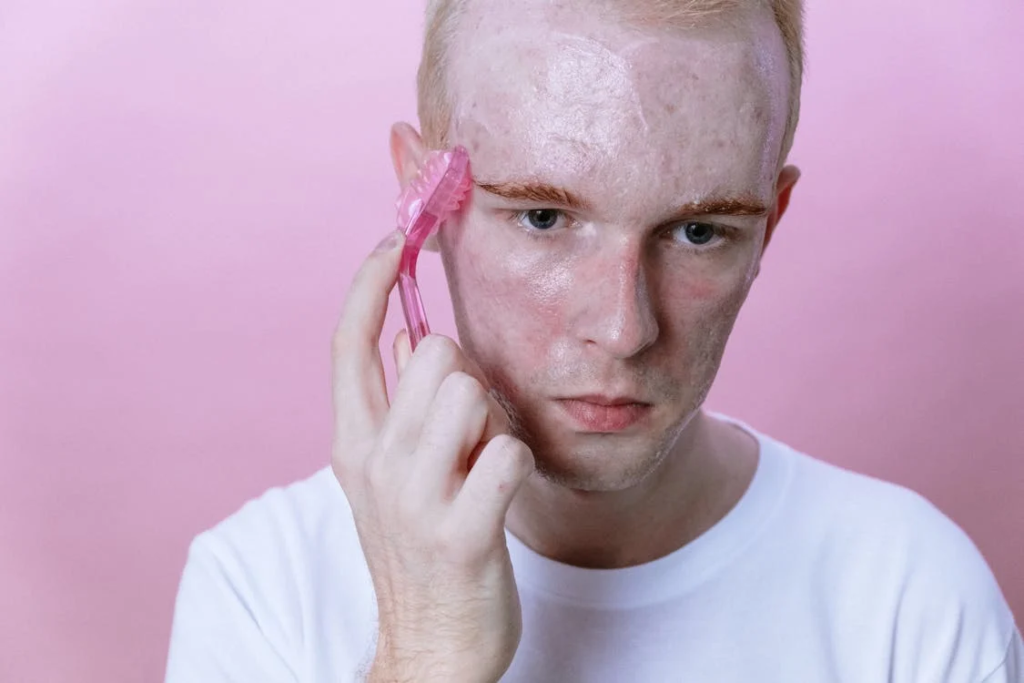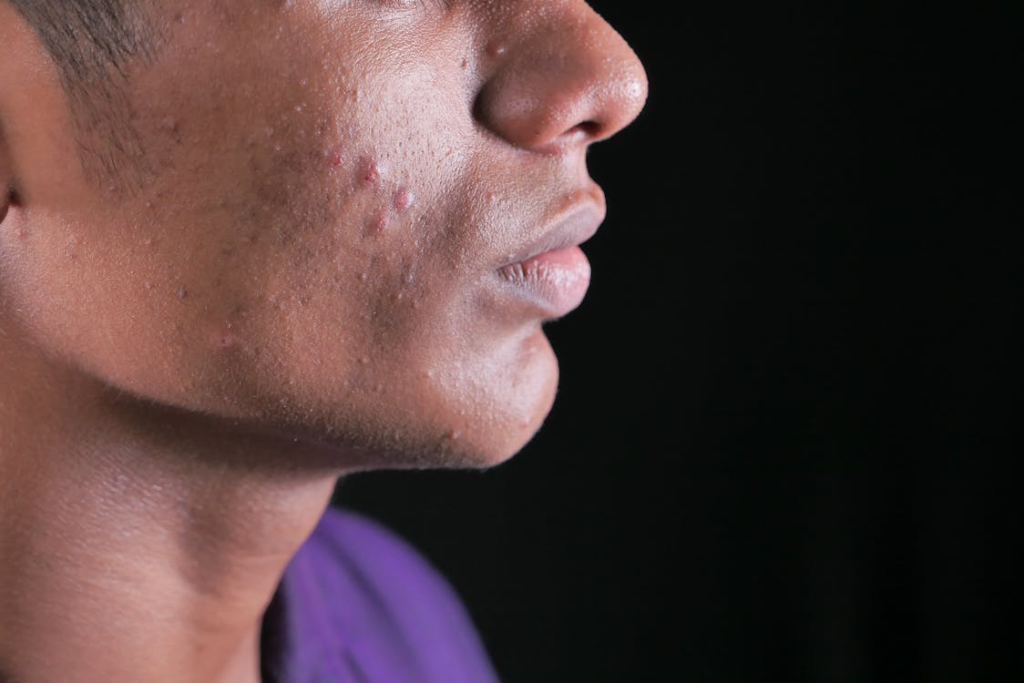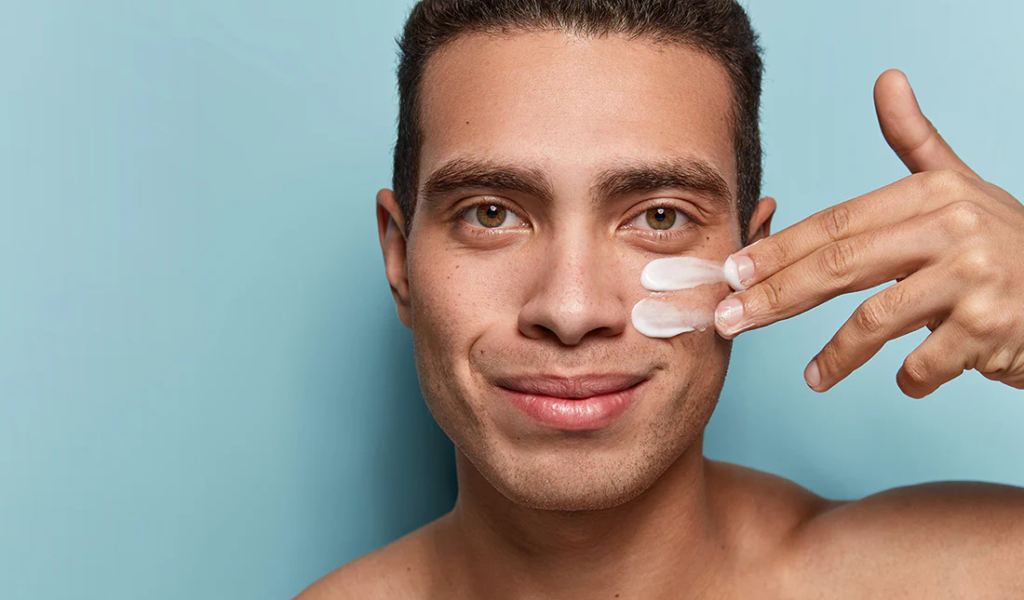Skincare is often viewed as a woman’s domain, but it is just as crucial for men. Daily exposure to environmental factors, pollution, and stress can lead to a host of skin issues. Taking care of your skin not only enhances your appearance but also boosts your confidence. Healthy skin reflects overall well-being and can even impact how others perceive you.

Common misconceptions about men’s skin care
Many men believe that their skin is inherently tougher and requires less maintenance, but this is a misconception. Men’s skin is generally oilier and thicker, which can lead to specific problems like acne and enlarged pores if not cared for properly. Recognizing the importance of a dedicated skincare routine is the first step toward achieving healthy skin.
Tip 1: Cleanse Daily
Cleansing is the foundation of any effective skincare routine. Throughout the day, your skin is exposed to dirt, pollution, sweat, and oils that can clog pores and lead to breakouts. If left unaddressed, these impurities can cause dullness, acne, and irritation. Regular cleansing helps to wash away these impurities, leaving the skin feeling fresh and revitalised. By removing the buildup, your skin can breathe better and absorb skincare products more effectively, enhancing overall skin health.
Choosing the Right Cleanser for Your Skin Type
Not all cleansers are created equal, and using the wrong one can do more harm than good. It is essential to select a cleanser that complements your skin type to ensure you achieve the best results:



- Oily skin: If you have oily skin, opt for a gel-based cleanser that can help control excess oil without over-drying. Gel cleansers work to deeply cleanse pores and prevent acne by reducing shine.
- Dry skin: For dry skin, hydration is key. A creamy or hydrating cleanser will cleanse your skin while adding moisture, preventing further dryness and flakiness.
- Sensitive skin: If your skin is prone to irritation or redness, look for fragrance-free and gentle cleansers. Harsh ingredients can worsen sensitivity, so it’s best to use mild, soothing formulas.
Proper Cleansing Technique
How you cleanse your skin matters just as much as the products you use. Follow these simple steps to ensure you get the most out of your cleansing routine:
- Start with lukewarm water – Wet your face with lukewarm water. Hot water can strip the skin of natural oils, while cold water may not effectively remove impurities.
- Apply cleanser – Use a small amount of cleanser and apply it to your face. Gently massage it in circular motions, focusing on areas prone to oil buildup, such as the forehead, nose, and chin. Massage for about 30 seconds to ensure thorough cleansing.
- Rinse thoroughly – Rinse your face with lukewarm water, ensuring all the cleanser is removed. Residual product can clog pores and lead to irritation.
- Pat dry – Use a clean towel to pat your face dry gently. Avoid rubbing, as this can irritate the skin and cause redness.
Tip 2: Exfoliate Weekly
Exfoliating helps remove dead skin cells that accumulate on the surface of the skin. This process reveals smoother, healthier skin underneath and prevents clogged pores, reducing the likelihood of breakouts. Regular exfoliation also improves skin texture, promotes cell regeneration, and enhances the effectiveness of other skincare products by allowing them to penetrate deeper.

How to Exfoliate Properly
Choosing the right exfoliant for your skin type is essential:
- Physical exfoliants: Scrubs with small particles are effective for oily skin but should be used sparingly to avoid irritation. Over-exfoliation can damage the skin barrier.
- Chemical exfoliants: Products containing alpha-hydroxy acids (AHAs) or beta-hydroxy acids (BHAs) provide a gentler form of exfoliation. These are ideal for sensitive or dry skin types and work by dissolving dead skin cells without the need for scrubbing.
Frequency of Exfoliation for Different Skin Types
- Oily skin: Exfoliate 2-3 times a week to keep pores clear and reduce shine.
- Dry skin: Limit exfoliation to once a week to prevent over-drying and irritation.
- Sensitive skin: Exfoliate once every two weeks, using mild, non-abrasive products to avoid triggering redness or inflammation.
Tip 3: Moisturise Regularly
Moisturising is essential to maintain the skin’s moisture balance and prevent dryness. By hydrating the skin, moisturisers create a protective barrier that helps keep skin soft, smooth, and healthy. This barrier can also shield the skin from environmental stressors, reducing the risk of irritation and damage. Consistent moisturising can improve overall skin texture and appearance.

Selecting the Right Moisturiser
Choose a moisturiser that fits your skin type to achieve optimal results:
- Oily skin: Lightweight, oil-free gel moisturisers are ideal for controlling excess shine without clogging pores.
- Dry skin: Rich, creamy moisturisers provide the hydration needed to soothe and nourish dry, flaky skin.
- Combination skin: Look for balancing formulas that hydrate dry areas while controlling oil in the T-zone.
How to Apply Moisturiser Effectively
To apply moisturiser correctly:
- After cleansing, take a small amount of moisturiser.
- Apply evenly to your face and neck, using upward strokes to promote circulation and absorption.
- Focus on dry areas and avoid using too much product on oily zones.
Tip 4: Use Sunscreen Daily
Sun exposure is one of the leading causes of skin damage. Ultraviolet (UV) rays from the sun can penetrate the skin, causing wrinkles, dark spots, and even increasing the risk of skin cancer over time. By consistently using sunscreen, you can protect your skin from these harmful effects, keeping it healthy and youthful.

Why It Matters for Men
Men are often outdoors for work, sports, or leisure, which increases sun exposure. Without proper protection, this exposure can accelerate aging and lead to long-term skin issues. Applying sunscreen is one of the simplest yet most important skin care tips for men to maintain healthy skin.
Choosing the Right SPF
SPF (Sun Protection Factor) is crucial for guarding against sunburn and UV damage. Broad-spectrum sunscreens protect against both UVA and UVB rays – the two types of UV light that harm skin.
- UVA rays cause aging by penetrating deep into the skin.
- UVB rays cause burns by damaging the outer layers.
Select a sunscreen with SPF 30 or higher to ensure maximum protection. This level blocks about 97% of UVB rays. Higher SPF offers slightly more coverage but must still be reapplied regularly.
How to Use Sunscreen Daily
Incorporating sunscreen into your routine doesn’t need to be complicated. Apply it every morning, even if the weather is cloudy or you plan to stay indoors. UV rays can pass through clouds and windows, making daily use essential.
For added convenience, use a moisturiser with SPF. This combination hydrates your skin while providing sun protection – saving time and simplifying your skincare routine.
Key Tip: Keep sunscreen visible in your bathroom or near your personal care products to remind you to apply it each day.
Following these simple skin care tips for men can prevent skin damage, preserve a youthful appearance, and promote long-term skin health.
Tip 5: Develop a Consistent Skincare Routine
A regular skincare routine helps keep your skin clear, healthy, and balanced. In the morning, cleansing your face removes oils that accumulate overnight. Applying moisturiser helps keep your skin hydrated and prevents dryness throughout the day. Sunscreen is essential to protect against harmful UV rays, even if you are indoors or it’s cloudy.

In the evening, cleansing again removes dirt, oil, and impurities collected during the day. This is the best time to use targeted treatments like serums, anti-aging creams, or acne solutions. These treatments work overnight to improve skin health. Finish with a moisturiser to keep the skin hydrated while you sleep.
Adapting Routines for Different Seasons
Your skin’s needs change with the weather, so your routine should adapt accordingly. In winter, cold air and indoor heating can dry out the skin. Use thicker, cream-based moisturisers to provide extra hydration and protect your skin barrier.
In summer, heat and humidity can cause excess oil and clogged pores. Switch to lightweight, oil-free moisturisers and gentle gel-based cleansers to keep your skin fresh and prevent breakouts. These adjustments are essential for maintaining healthy skin year-round.
Seasonal changes are especially important for those seeking winter skin care tips or oily skin care tips for men.
Sticking to the Routine for Best Results
Consistency is the key to effective skincare. Even the best products won’t work if you use them sporadically. Incorporate your skincare routine into your daily schedule by making it part of your morning and evening rituals.
Set reminders on your phone or keep your products where you’ll see them every day – like next to your toothbrush. Skincare should be simple and easy to maintain. Over time, following this routine will lead to noticeable improvements, helping you achieve smooth, clear skin.
Small daily efforts lead to long-term benefits, making skincare an essential part of self-care.
Tip 6: Address Specific Skin Concerns
Oily Skin Care Tips for Men
Oily skin can lead to clogged pores, acne, and unwanted shine. To manage this, choose oil-free and non-comedogenicproducts that won’t block pores. A gel-based cleanser can help remove excess oil without drying out the skin. Adding a toner to your routine can further reduce oil production by tightening pores and balancing the skin. Toners with ingredients like witch hazel or salicylic acid are effective in controlling shine and preventing breakouts.
Dry Skin Care Tips for Men
Dry skin can feel tight, itchy, and flaky. Moisturising regularly is essential, but you can enhance hydration by using a humidifier at home. This increases moisture in the air, preventing the skin from drying out, especially during winter. Choose rich, cream-based moisturisers that deeply hydrate and repair the skin barrier. Look for ingredients like hyaluronic acid, shea butter, or glycerin that lock in moisture. Avoid hot showers and harsh cleansers, as they strip away natural oils, worsening dryness.
Combination Skin Solutions
Combination skin requires a tailored approach. This skin type typically features an oily T-zone (forehead, nose, chin)with dry cheeks. The best solution is to use different products for different areas. Apply a lightweight, oil-free moisturiser on the oily parts and a richer cream on the drier areas. Use a balancing cleanser that doesn’t over-dry the skin but controls oil. Gentle exfoliation can help manage flaky patches without aggravating oil production.
Addressing specific skin concerns with targeted products ensures better results, contributing to healthier, clearer skin.
Tip 7: Stay Hydrated and Eat a Balanced Diet
Drinking enough water is one of the simplest yet most effective ways to improve your skin. When you’re hydrated, your skin stays elastic, plump, and less prone to dryness and wrinkles. Water helps flush out toxins that can cause breakouts and irritation. Dehydrated skin, on the other hand, can appear dull, flaky, and more prone to fine lines. Aim for at least 8 glasses of water a day or more if you exercise frequently or live in a hot climate. Keeping a water bottle with you throughout the day can serve as a helpful reminder.
Foods That Promote Healthy Skin
Your diet plays a significant role in skin health. Fruits and vegetables rich in antioxidants help protect skin cells from damage caused by free radicals. Leafy greens, berries, and citrus fruits are excellent choices.
Omega-3 fatty acids, found in salmon, walnuts, and flaxseeds, help reduce inflammation and keep the skin hydrated from within. These fats can also help with conditions like eczema and acne.
Make sure to include foods high in vitamins A, C, and E.
- Vitamin A (found in sweet potatoes and carrots) aids skin cell turnover.
- Vitamin C (in oranges, strawberries, and bell peppers) boosts collagen production, keeping the skin firm.
- Vitamin E (in almonds and spinach) protects the skin from oxidative stress and helps with healing.
Read More: How an Anti-Inflammatory Diet Can Help You Shed Stubborn Pounds
Avoiding Foods That May Negatively Affect Skin
Certain foods can trigger skin problems, particularly acne and inflammation. Limit your intake of processed foods, sugary snacks, and dairy, as they can lead to increased oil production and clogged pores. High-sugar diets may also break down collagen, accelerating the appearance of wrinkles and sagging skin.
Instead, focus on whole, natural foods that nourish your skin from the inside out. Reducing alcohol and caffeine can also prevent dehydration, further benefiting skin health.
Read More: Top 10 Superfoods to Add to Your Daily Diet
Tip 8: Get Adequate Sleep
Getting enough sleep isn’t just good for your overall health – it’s essential for your skin. During sleep, your body goes into repair mode, producing new skin cells and repairing damage from UV exposure, pollution, and daily stress. This process keeps your skin looking fresh, firm, and youthful. When you don’t get enough rest, your skin shows it. Dark circles, puffiness, and dull, tired-looking skin are common signs of sleep deprivation. Over time, lack of sleep can lead to fine lines, breakouts, and uneven skin tone. Aim for 7 to 9 hours of quality sleep each night to help your skin stay healthy and glowing.

Tips for Improving Sleep Quality
Improving your sleep doesn’t have to be complicated. A few simple changes can make a big difference:
- Stick to a schedule – Go to bed and wake up at the same time every day, even on weekends. Consistency helps regulate your body’s natural clock, leading to better sleep.
- Create a bedtime routine – Wind down with relaxing activities like reading, light stretching, or meditation. A calming routine signals your body that it’s time to rest.
- Limit screen time – Avoid screens (phones, tablets, TVs) at least an hour before bed. The blue light from screens can interfere with your sleep by reducing melatonin production.
- Optimise your environment – Keep your bedroom cool, dark, and quiet. Investing in blackout curtains or a white noise machine can improve your sleep environment.
Nighttime Skincare Routine
Your skin naturally loses moisture overnight, so having a simple nighttime skincare routine is key.
- Cleanse your skin to remove dirt, oil, and impurities accumulated during the day. This prevents clogged pores and breakouts.
- Apply a night cream or hydrating moisturiser to lock in moisture and help your skin regenerate as you sleep. For added benefits, use products containing retinol, hyaluronic acid, or peptides, which support collagen production and cell turnover.
- Eye cream can also help reduce puffiness and fine lines around the eyes by morning.
Tip 9: Manage Stress
Stress doesn’t just affect your mood – it shows up on your skin too. When you’re stressed, your body produces more cortisol (the stress hormone), which can increase oil production and lead to breakouts, acne, and inflammation. Stress can also worsen skin conditions like eczema, psoriasis, and rosacea, making them harder to manage. Over time, chronic stress can speed up the aging process, causing fine lines and dull skin. By managing stress, you help your skin stay clear, healthy, and glowing.
Stress-Reduction Techniques for Better Skin
Reducing stress can significantly improve skin health. Simple, daily activities can lower cortisol levels and improve your overall well-being:
- Deep breathing and meditation – Just 5 to 10 minutes of deep breathing or meditation can relax your body and mind, reducing tension.
- Exercise and yoga – Physical activity releases endorphins (feel-good hormones), which help counteract the effects of stress. Yoga, in particular, combines physical movement with mindfulness, promoting relaxation.
- Hobbies and fun activities – Engaging in hobbies, whether it’s painting, reading, or gardening, helps shift your focus away from stressors.
- Time outdoors – Fresh air and nature can calm the mind, reduce stress, and boost your mood, all of which reflect positively on your skin.
Incorporating Relaxation into Your Skincare Routine
Turn your daily skincare routine into a moment of self-care and relaxation. Instead of rushing through it, take a few extra minutes to enjoy the process. Light a candle, play calming music, or practice mindfulness as you cleanse and moisturise your skin.
- Massage your face gently while applying products to boost circulation and ease tension.
- Use products with calming scents like lavender or chamomile to create a spa-like experience at home.
Read More: 10 Proven Ways to Naturally Lower Cortisol Levels
Tip 10: Regular Professional Skin Check-ups
Visiting a dermatologist isn’t just for treating skin problems – it’s a proactive step in maintaining healthy skin. Regular check-ups help identify potential skin issues early, such as skin cancer, moles, or other abnormalities that might go unnoticed. A dermatologist can also provide personalised advice tailored to your skin type, helping address concerns like acne, dryness, or aging more effectively than over-the-counter products. By catching issues early, you can prevent them from developing into more serious conditions.
How Often to Schedule Check-ups
For most people, an annual visit to the dermatologist is sufficient to keep skin health in check. However, if you have specific skin conditions (such as eczema, psoriasis, or persistent acne), or if you notice unusual changes like new moles, persistent rashes, or discoloration, more frequent visits may be necessary. Regular check-ups become even more important if there is a family history of skin cancer or if you spend a lot of time outdoors.
What to Expect During a Skin Examination
A professional skin check-up is a straightforward and painless process. During the exam, the dermatologist will:
- Inspect your skin from head to toe, looking for any suspicious moles, rashes, or irregularities.
- Examine sun-exposed areas that are more prone to damage, such as the face, neck, and hands.
- Discuss any concerns you have, whether it’s about acne, dryness, or signs of aging.
You may also receive recommendations for treatments or products suited to your skin type. Don’t hesitate to ask questions about your current skincare routine – dermatologists can offer valuable skin care tips for men that address individual needs and goals.
Proactive skin care through regular professional check-ups ensures long-term skin health and prevents minor issues from becoming major concerns.
Developing a skincare routine isn’t just about looking good – it’s about protecting and maintaining your skin’s health over time. Taking the first step in skincare can feel overwhelming, but starting small makes a difference. Don’t wait for breakouts, dryness, or sun damage to show up before taking action. By gradually incorporating daily cleansing, moisturising, and sunscreen, you build the foundation for healthier skin. Over time, adding exfoliation, hydration, and professional check-ups will enhance the results. The sooner you start, the sooner you’ll notice improvements – from clearer skin to fewer wrinkles and better texture.
Skincare isn’t just about short-term fixes. Consistently caring for your skin helps prevent premature aging, reduces the risk of skin cancer, and keeps skin firm and glowing for years to come. Think of skincare as a long-term investment in your health. By addressing your skin’s needs now, you’ll look and feel better as you age. Additionally, caring for your skin boosts confidence and promotes overall wellness.
Start today – your future self will thank you for the effort you put into your skin now.



